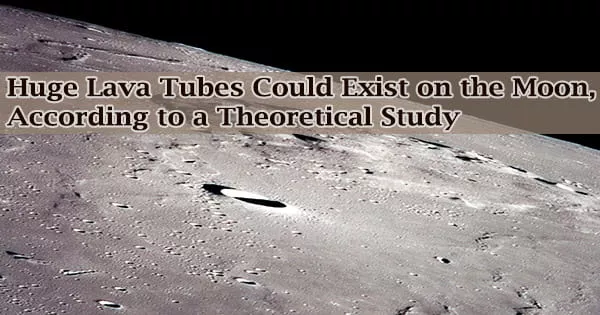According to a theoretical research presented at the Lunar and Planetary Science Conference on March 17, lava tubes large enough to host cities on the moon could be structurally stable.
Because they could provide protection from cosmic radiation, meteorite impacts, and temperature extremes, the volcanic features are an important target for future human space exploration.
Lava tubes are tunnels produced by volcanic eruptions’ lava flows. As the lava flows, the edges cool, forming a pipe-like crust surrounding the flowing river of lava.
According to Jay Melosh, a Purdue University distinguished professor of earth, atmospheric, and planetary sciences who is engaged in the research, when the eruption finishes and the lava flow stops, the pipe drains leave behind a hollow tunnel.
“There has been some discussion of whether lava tubes might exist on the moon,” he said. “Some evidence, like the sinuous rilles observed on the surface, suggest that if lunar lava tubes exist they might be really big.”
Large grooves visible on the lunar surface presumed to be produced by lava flows are known as sinuous rilles. The sinuous rilles can be up to 10 kilometers wide, and the Purdue team wanted to see if there were any lava tubes on a similar scale.
The study, lead by David Blair, a doctoral student in Purdue’s Department of Earth, Atmospheric, and Planetary Sciences, looked at whether empty lava tubes larger than 1 kilometer wide on the moon might stay structurally stable.
There has been some discussion of whether lava tubes might exist on the moon. Some evidence, like the sinuous rilles observed on the surface, suggest that if lunar lava tubes exist they might be really big.
Jay Melosh
“We found that if lunar lava tubes existed with a strong arched shape like those on Earth, they would be stable at sizes up to 5,000 meters, or several miles wide, on the moon,” Blair said.
“This wouldn’t be possible on Earth, but gravity is much lower on the moon and lunar rock doesn’t have to withstand the same weathering and erosion. In theory, huge lava tubes big enough to easily house a city could be structurally sound on the moon.”
Blair collaborated with Antonio Bobet, a Purdue civil engineering professor, to apply what they knew about lunar rock and the moon’s environment to civil engineering technology used to build tunnels on Earth.
The researchers discovered that the stability of a lava tube was affected by the width, roof thickness, and stress condition of the cooled lava, and they modeled a variety of these variables. According to Blair, the researchers also modeled lava tubes with walls made of one thick layer of lava and those made of several thin layers of lava.
Only one other study, published in 1969, has attempted to model lunar lava tubes, he said.
In addition to Melosh, Blair, and Bobet, team members include Loic Chappaz and Rohan Sood, graduate students in the School of Aeronautics and Astronautics; Kathleen Howell, Purdue’s Hsu Lo Professor of Aeronautical and Astronautical Engineering; Andy M. Freed, an associate professor of earth, atmospheric and planetary sciences; and Colleen Milbury, a postdoctoral research associate in the Department of Earth, Atmospheric and Planetary Sciences.





